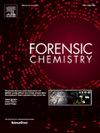基于热性能分析的血液成分变化与可视化增强结果及形态演变的相关性研究
IF 2.6
3区 医学
Q2 CHEMISTRY, ANALYTICAL
引用次数: 0
摘要
在使用化学试剂时,血液在加热过程中的形态演变和成分变化对于理解可视化增强的结果至关重要。考虑到血液成分的复杂性,人类和其他两种哺乳动物的血液样本首先进行离心处理,制备成干燥的全血、干燥的红细胞和干燥的血浆,用于进一步的TG-IR分析。结果表明,血液的分解过程可分为35 ~ 190℃、190 ~ 430℃、430 ~ 610℃和610 ~ 800℃四个阶段。在第二阶段,脂质和蛋白质进行热分解,随着NH3和CO2的释放,血液质量损失约50%,由于气体的快速释放,出现明显的凸起,呈现黑色金属外观。在310°C加热5分钟后,通过鲁米醇测试可以看到血迹。在400°C加热5分钟后,使用四甲基联苯胺(TMB)可以获得正反应。在第三阶段,质量损失进一步降低了约40%。表面出现条状或块状断裂,金属光泽基本消失。在480℃下加热5 min后,血迹可见阴性,说明血红蛋白已完全分解。在610℃以上加热时,热分解过程逐渐减少,在880℃左右完成,纤维残留物最少。加热过程中血液成分的变化与形态进化和可视化增强相关,为火灾现场血液检测提供了依据。本文章由计算机程序翻译,如有差异,请以英文原文为准。
Correlation of compositional change with visualization enhancement results and morphology evolution of blood based on thermal performance analysis
The morphology evolution and compositional change of blood during heating are crucial for understanding the results of visualization enhancement when using chemical reagents. Given the complexity of blood composition, human and two other mammalian blood samples were initially centrifuged and prepared as dried whole blood, dried erythrocytes, and dried plasma for further TG-IR analysis. The results indicated that the decomposition process of blood could be divided into four distinct stages: 35-190 °C, 190-430 °C, 430-610 °C, and 610-800 °C. In the second stage, lipids and proteins underwent thermal decomposition, resulting in an approximately 50 % mass loss of blood with the release of NH3 and CO2, and obvious bulges presented with a black metallic appearance due to the rapid release of gases. The bloodstains could be visualized by the luminol test after heating at 310 °C for 5 min. Also, a positive reaction could be obtained by using tetramethylbenzidine (TMB) after heating at 400 °C for 5 min. In the third stage, the mass loss was further reduced by approximately 40 %. The streaks or block-like fractures appeared on the surface, with the metallic luster largely disappearing. Negative visualization results were obtained from bloodstains after heating at 480 °C for 5 min, suggesting that the hemoglobin was completely decomposed. The thermal decomposition process was gradually decreased when heating above 610 °C and completed around 880 °C, with minimal fibrous residues left. The compositional changes of blood during heating were correlated with morphology evolution and visualization enhancement, providing the evidence for blood detection in fire scenes.
求助全文
通过发布文献求助,成功后即可免费获取论文全文。
去求助
来源期刊

Forensic Chemistry
CHEMISTRY, ANALYTICAL-
CiteScore
5.70
自引率
14.80%
发文量
65
审稿时长
46 days
期刊介绍:
Forensic Chemistry publishes high quality manuscripts focusing on the theory, research and application of any chemical science to forensic analysis. The scope of the journal includes fundamental advancements that result in a better understanding of the evidentiary significance derived from the physical and chemical analysis of materials. The scope of Forensic Chemistry will also include the application and or development of any molecular and atomic spectrochemical technique, electrochemical techniques, sensors, surface characterization techniques, mass spectrometry, nuclear magnetic resonance, chemometrics and statistics, and separation sciences (e.g. chromatography) that provide insight into the forensic analysis of materials. Evidential topics of interest to the journal include, but are not limited to, fingerprint analysis, drug analysis, ignitable liquid residue analysis, explosives detection and analysis, the characterization and comparison of trace evidence (glass, fibers, paints and polymers, tapes, soils and other materials), ink and paper analysis, gunshot residue analysis, synthetic pathways for drugs, toxicology and the analysis and chemistry associated with the components of fingermarks. The journal is particularly interested in receiving manuscripts that report advances in the forensic interpretation of chemical evidence. Technology Readiness Level: When submitting an article to Forensic Chemistry, all authors will be asked to self-assign a Technology Readiness Level (TRL) to their article. The purpose of the TRL system is to help readers understand the level of maturity of an idea or method, to help track the evolution of readiness of a given technique or method, and to help filter published articles by the expected ease of implementation in an operation setting within a crime lab.
 求助内容:
求助内容: 应助结果提醒方式:
应助结果提醒方式:


